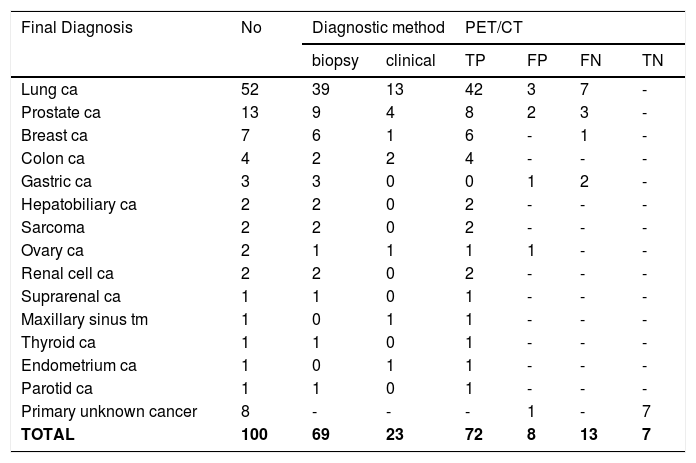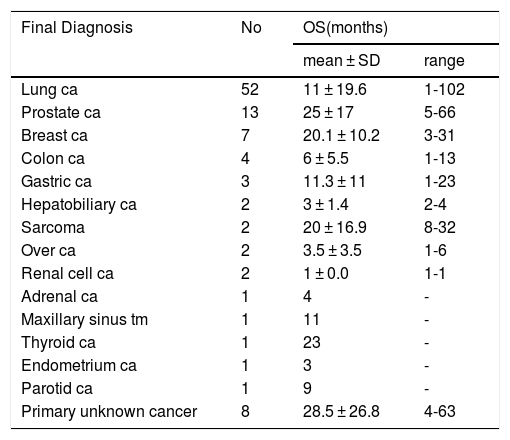The present study investigates the role of 18F-FDG PET/CT in the detection of primary malignancy in patients with bone metastasis of unknown primary origin (BMUO).
Material and MethodsThis retrospective study considered histopathological examination findings or clinical follow-up data as the standard reference in the diagnosis of primary tumors, and results were compared with results of PET/CT scans.
ResultsThe study included 100 patients with BMUO (74 males, 26 females, mean age 61 years). The primary origin was identified in 92 of the 100 patients. Adenocarcinoma was the most common histopathological subtype in patients in whom the primary origin of tumor was detected (65.2%). The most common primary tumor was lung carcinoma (n = 52) followed by prostate (n = 13), breast (n = 7), colon (n = 4), gastric (n = 3), ovarian (n = 2), renal cell (n = 2), adrenal(n = 1), thyroid (n = 1), endometrial (n = 1) and parotid (n = 1) carcinoma, hepatobiliary cancers (n = 2), leiomyosarcoma (n = 2) and maxillary sinus tumor (n = 1). The numbers of patients in whom PET/CT showed true positive, true negative, false positive (FP) and false negative (FN) results were 72, 7, 8 and 13, respectively. The sensitivity, specificity, accuracy and detection rate of PET/CT in detecting the primary tumor were 84.7%, 46%, 79% and 72%, respectively. The overall survival was significantly lower in lung cancer group when compared to non-lung cancer group, whereas it was significantly higher in prostate cancer group than in non-prostate cancer group.
ConclusionsPET/CT, as a non-invasive method, can be preferred as the first choice in the detection of primary tumor in patients with BMUO.
Este trabajo analiza el papel de la PET/TC con 18F-FDG en la detección del tumor primario en pacientes con metástasis óseas de origen desconocido (MOOD).
Material y MétodosEste estudio retrospectivo consideró al análisis histopatológico o el seguimiento clínico como datos de referencia en el diagnóstico de tumores primarios y estos resultados fueron comparados con los resultados de la PET/TC.
ResultadosSe incluyeron 100 pacientes con MOOD (74 hombres, 26 mujeres; edad media de 61 años). El tumor primario se identificó en 92 de los 100 pacientes. El tipo histopatológico más común en los pacientes en los que se detectó el tumor primario fue el adenocarcinoma (65.2%). El tumor primario más frecuente fue el cáncer de pulmón (n = 52) seguido por los tumores de próstata (n = 13), mama (n = 7), colon (n = 4), estómago (n = 3), ovario (n = 2), riñón (n = 2), suprarrenal (n = 1), tiroides (n = 1), endometrio (n = 1), parótida (n = 1), carcinoma hepatobiliar (n = 2), leiomiosarcoma (n = 2) y tumor del seno maxilar (n = 1). Para la PET/TC, el número de pacientes con resultados verdaderos positivos, verdaderos negativos, falsos positivos y falsos negativos fue de 72, 7, 8 y 13, respectivamente. La sensibilidad, especificidad, exactitud y índice de detección de la PET/TC en la detección del tumor primario fue de 84.7%, 46%, 79% and 72%, respectivamente. La supervivencia global fue significativamente inferior en el grupo con cáncer de pulmón cuando se comparó con el grupo no-cáncer de pulmón, mientras que fue significativamente más elevada en el grupo con cáncer de próstata que en el grupo no-cáncer de próstata.
ConclusionesLa PET/TC, como método no invasivo, podría ser la técnica de elección en la detección del tumor primario en pacientes con MOOD.
Article

Revista Española de Medicina Nuclear e Imagen Molecular (English Edition)










